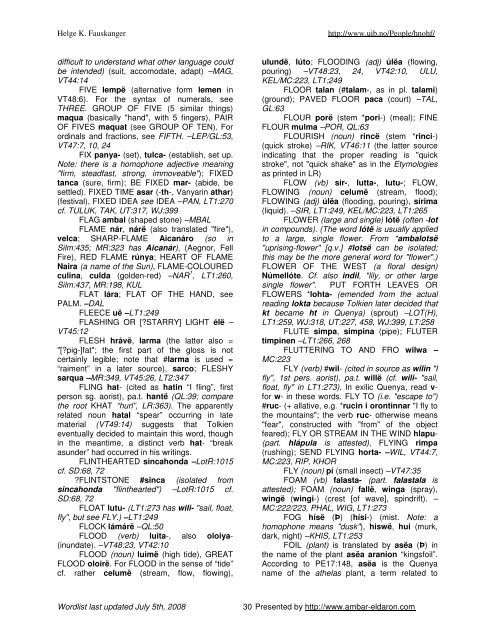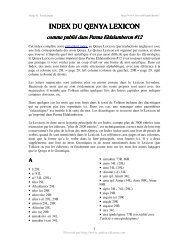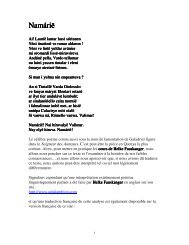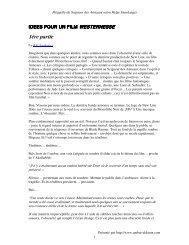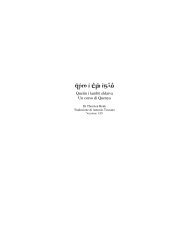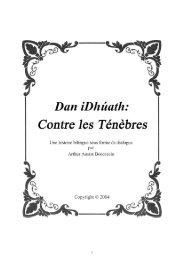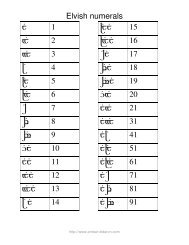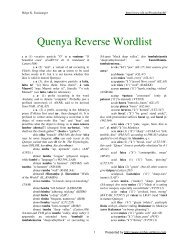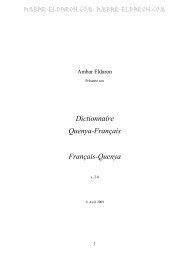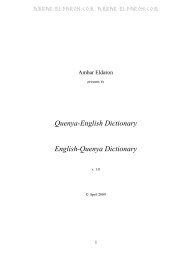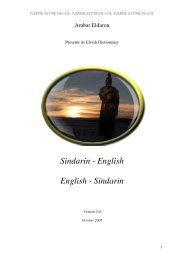English – Quenya - Ambar Eldaron
English – Quenya - Ambar Eldaron
English – Quenya - Ambar Eldaron
Create successful ePaper yourself
Turn your PDF publications into a flip-book with our unique Google optimized e-Paper software.
Helge K. Fauskanger http://www.uib.no/People/hnohf/<br />
difficult to understand what other language could<br />
be intended) (suit, accomodate, adapt) <strong>–</strong>MAG,<br />
VT44:14<br />
FIVE lempë (alternative form lemen in<br />
VT48:6). For the syntax of numerals, see<br />
THREE. GROUP OF FIVE (5 similar things)<br />
maqua (basically "hand", with 5 fingers), PAIR<br />
OF FIVES maquat (see GROUP OF TEN). For<br />
ordinals and fractions, see FIFTH. <strong>–</strong>LEP/GL:53,<br />
VT47:7, 10, 24<br />
FIX panya- (set), tulca- (establish, set up.<br />
Note: there is a homophone adjective meaning<br />
"firm, steadfast, strong, immoveable"); FIXED<br />
tanca (sure, firm); BE FIXED mar- (abide, be<br />
settled). FIXED TIME asar (-th-, Vanyarin athar)<br />
(festival), FIXED IDEA see IDEA <strong>–</strong>PAN, LT1:270<br />
cf. TULUK, TAK, UT:317, WJ:399<br />
FLAG ambal (shaped stone) <strong>–</strong>MBAL<br />
FLAME nár, nárë (also translated "fire"),<br />
velca; SHARP-FLAME Aicanáro (so in<br />
Silm:435; MR:323 has Aicanár), (Aegnor, Fell<br />
Fire), RED FLAME rúnya; HEART OF FLAME<br />
Naira (a name of the Sun), FLAME-COLOURED<br />
culina, culda (golden-red) <strong>–</strong>NAR 1 , LT1:260,<br />
Silm:437, MR:198, KUL<br />
FLAT lára; FLAT OF THE HAND, see<br />
PALM. <strong>–</strong>DAL<br />
FLEECE uë <strong>–</strong>LT1:249<br />
FLASHING OR [?STARRY] LIGHT élë <strong>–</strong><br />
VT45:12<br />
FLESH hrávë, larma (the latter also =<br />
"[?pig-]fat"; the first part of the gloss is not<br />
certainly legible; note that #larma is used =<br />
“raiment” in a later source), sarco; FLESHY<br />
sarqua <strong>–</strong>MR:349, VT45:26, LT2:347<br />
FLING hat- (cited as hatin “I fling”, first<br />
person sg. aorist), pa.t. hantë (QL:39; compare<br />
the root KHAT “hurl”, LR:363). The apparently<br />
related noun hatal “spear” occurring in late<br />
material (VT49:14) suggests that Tolkien<br />
eventually decided to maintain this word, though<br />
in the meantime, a distinct verb hat- “break<br />
asunder” had occurred in his writings.<br />
FLINTHEARTED sincahonda <strong>–</strong>LotR:1015<br />
cf. SD:68, 72<br />
?FLINTSTONE #sinca (isolated from<br />
sincahonda "flinthearted") <strong>–</strong>LotR:1015 cf.<br />
SD:68, 72<br />
FLOAT lutu- (LT1:273 has wili- "sail, float,<br />
fly", but see FLY.) <strong>–</strong>LT1:249<br />
FLOCK lámárë <strong>–</strong>QL:50<br />
FLOOD (verb) luita-, also oloiya-<br />
(inundate). <strong>–</strong>VT48:23, VT42:10<br />
FLOOD (noun) luimë (high tide), GREAT<br />
FLOOD oloirë. For FLOOD in the sense of “tide”<br />
cf. rather celumë (stream, flow, flowing),<br />
ulundë, lúto; FLOODING (adj) úlëa (flowing,<br />
pouring) <strong>–</strong>VT48:23, 24, VT42:10, ULU,<br />
KEL/MC:223, LT1:249<br />
FLOOR talan (#talam-, as in pl. talami)<br />
(ground); PAVED FLOOR paca (court) <strong>–</strong>TAL,<br />
GL:63<br />
FLOUR porë (stem *pori-) (meal); FINE<br />
FLOUR mulma <strong>–</strong>POR, QL:63%<br />
FLOURISH (noun) rincë (stem *rinci-)<br />
(quick stroke) <strong>–</strong>RIK, VT46:11 (the latter source<br />
indicating that the proper reading is "quick<br />
stroke", not "quick shake" as in the Etymologies<br />
as printed in LR)<br />
FLOW (vb) sir-, lutta-, lutu-; FLOW,<br />
FLOWING (noun) celumë (stream, flood);<br />
FLOWING (adj) úlëa (flooding, pouring), sírima<br />
(liquid). <strong>–</strong>SIR, LT1:249, KEL/MC:223, LT1:265<br />
FLOWER (large and single) lótë (often -lot<br />
in compounds). (The word lótë is usually applied<br />
to a large, single flower. From *ambalotsë<br />
"uprising-flower" [q.v.] #lotsë can be isolated;<br />
this may be the more general word for "flower".)<br />
FLOWER OF THE WEST (a floral design)<br />
Númellóte. Cf. also indil, "lily, or other large<br />
single flower". PUT FORTH LEAVES OR<br />
FLOWERS *lohta- (emended from the actual<br />
reading lokta because Tolkien later decided that<br />
kt became ht in <strong>Quenya</strong>) (sprout) <strong>–</strong>LOT(H),<br />
LT1:259, WJ:318, UT:227, 458, WJ:399, LT:258<br />
FLUTE simpa, simpina (pipe); FLUTER<br />
timpinen <strong>–</strong>LT1:266, 268<br />
FLUTTERING TO AND FRO wilwa <strong>–</strong><br />
MC:223<br />
FLY (verb) #wil- (cited in source as wilin "I<br />
fly", 1st pers. aorist), pa.t. willë (cf. wili- "sail,<br />
float, fly" in LT1:273). In exilic <strong>Quenya</strong>, read v-<br />
for w- in these words. FLY TO (i.e. "escape to")<br />
#ruc- (+ allative, e.g. *rucin i orontinnar "I fly to<br />
the mountains"; the verb ruc- otherwise means<br />
"fear", constructed with "from" of the object<br />
feared); FLY OR STREAM IN THE WIND hlapu-<br />
(part. hlápula is attested), FLYING rimpa<br />
(rushing); SEND FLYING horta- <strong>–</strong>WIL, VT44:7,<br />
MC:223, RIP, KHOR<br />
FLY (noun) pí (small insect) <strong>–</strong>VT47:35<br />
FOAM (vb) falasta- (part. falastala is<br />
attested); FOAM (noun) fallë, winga (spray),<br />
wingë (wingi-) (crest [of wave], spindrift). <strong>–</strong><br />
MC:222/223, PHAL, WIG, LT1:273<br />
FOG hísë (Þ) (hísi-) (mist. Note: a<br />
homophone means "dusk"), hiswë, hui (murk,<br />
dark, night) <strong>–</strong>KHIS, LT1:253<br />
FOIL (plant) is translated by asëa (Þ) in<br />
the name of the plant asëa aranion “kingsfoil”.<br />
According to PE17:148, asëa is the <strong>Quenya</strong><br />
name of the athelas plant, a term related to<br />
Wordlist last updated July 5th, 2008 30 Presented by http://www.ambar-eldaron.com


